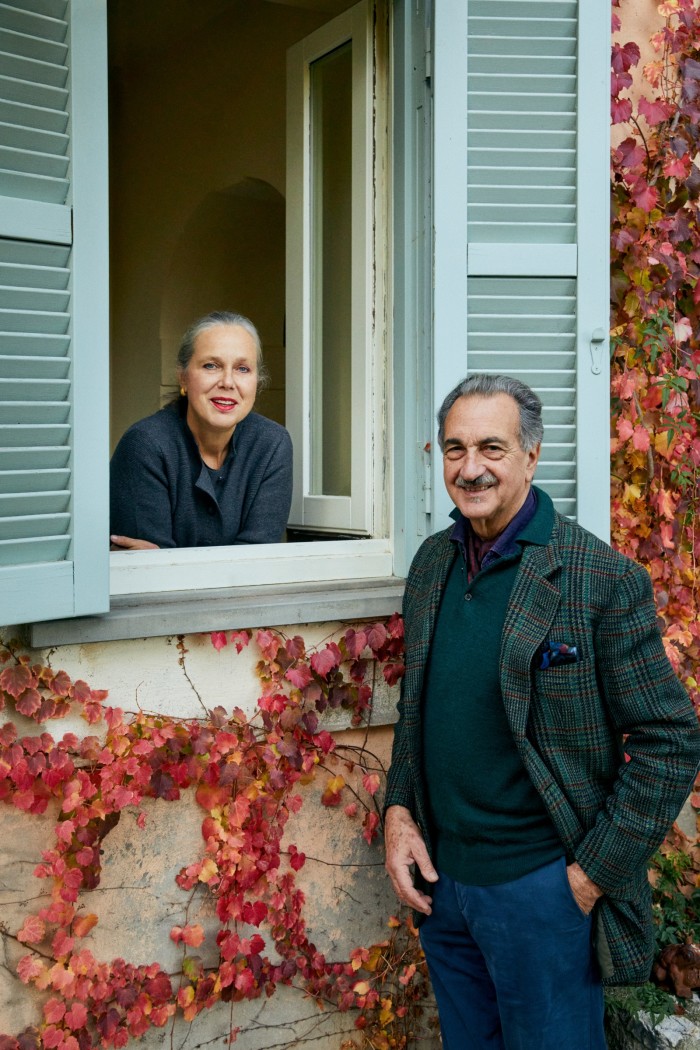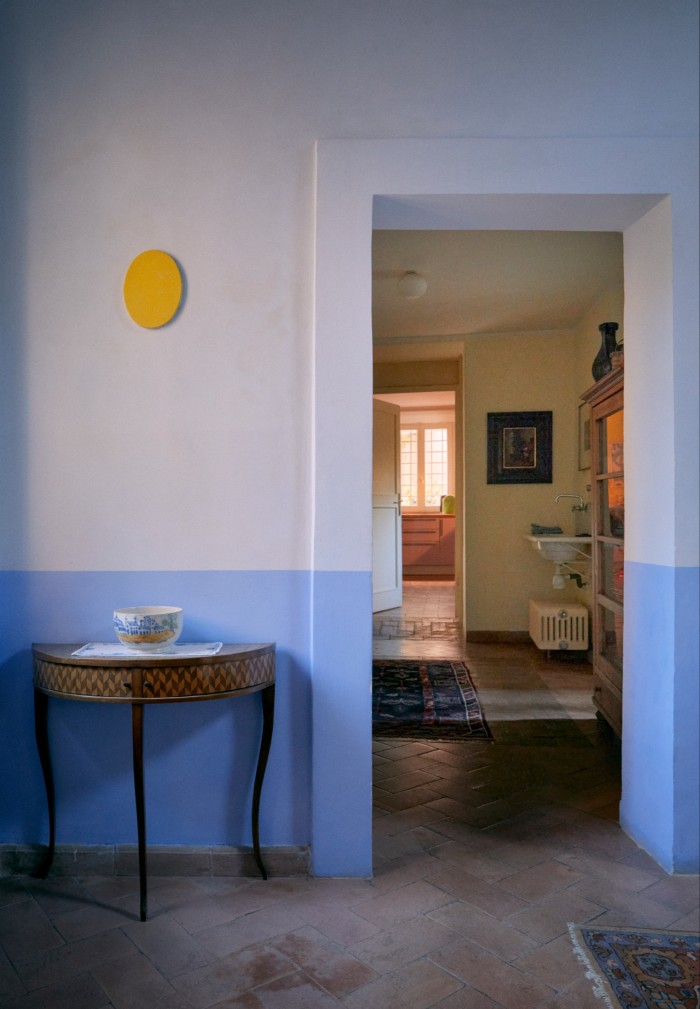A farewell to farms

Roula Khalaf, Editor of the FT, selects her favourite stories in this weekly newsletter.
A small village in Sabina in Italy’s Rieti province has been my country home for 15 years. Named after Rome’s patron saint, Castel San Pietro is an hour by car from the capital, but is a voyage far back in time. This hilly region was settled thousands of years ago, with a pastoral base preceding systematic agriculture; many roads winding through Sabina were paths once used for the transhumance, the passage of humans and animals toward the valleys in winter, and up the mountains in summer.
My husband Giuseppe Catalano di Melilli and I settled on Castel San Pietro as a fusion of our backgrounds. He’s a lighting architect and farmer from a notable Sicilian family, and great-nephew of the writer Giovanni Verga. We met in Rome; I had lived between New York City, Belgium, and San Casciano dei Bagni, Tuscany, with two daughters from my marriage to the American artist Joseph Kosuth. Sabina is mythical, with an aesthetic both contemporary and prehistoric. Giuseppe and I sought a hideaway to experience nature in full and yet live within a village.

Over the years, we savoured local customs, foods and conversations, doing our part to keep the spirit of an ancient community alive. We tended the land with eternity in mind, temporary stewards though we are. Our home overlooks what once was an ancient Roman villa estate, said to have belonged to the emperor Diocletian. Its stepped terraces are built in a style channelling Near Eastern hanging gardens. The lowest ramp gives way to a surprise vista, a dropped-down secret garden, protected by steep walls, and a view of Rome. This open-air greenhouse is a historic specimen garden filled with many plant varieties, and two small ponds. It shelters delicate citrus plants from climate shifts, today, as long ago.


The olive groves and vineyards on our small farm have given rise to our own olive oil and wine brand, Agricola Due Leoni. We collaborated with contemporary artists on special editions of our product, fusing our knowledge bases slowly, and not without raised voices. We worked with Emilio Corti, an artist from northern Italy, and I solicited proposals from a few former students, now established creatives. One of these, Mario Ciaramitaro, developed the wine labels under Giuseppe’s watchful eye, while I took control of the art direction on the olive oil cans.
We built up clients by travelling around with olive oil and wine in the back of the car. To launch a food product requires not only the year-round growing of a product, and subsequent registering with food authorities, but an entire branded image to function seamlessly. When I pulled up to the Art Basel fair, my colleagues were astonished to see me delivering five-litre olive oil cans in service of artist Alison Knowles, and a giant recreation of her 1962 performance Make a Salad. I was as passionate then about the cause of agriculture in relation to art and sustainability as I am today.
Farmers everywhere are the base of our lives and yet an undervalued group of workers. The culture and wisdom of people in agriculture is never mapped in visual studies, yet every vegetable stand run by a farmer must be an aesthetic composition. Farming as an aesthetic of the land keeps Europe looking like it does and turns a flight descending into Rome into an astounding glide across fields cultivated over millennia. I remember reading Virgil in college and being utterly moved by pastoral poetry.


The sheer incredulity of participating in such an ancient symbiosis convinced not only me but many artists to help our Due Leoni agricultural project. I have long hosted artists in residencies. As a college student at Oberlin College in the 1970s, I espoused communal living, organic food and The Moosewood Cookbook. Now Giuseppe and I were farming the stuff we were eating. Of course, always with the help of many hands, and that included local workers, as well as visiting students from exchange programmes such as Workaway.
Giuseppe and I have grown as a couple from the experience of mentoring and guiding young people on the land; they, in turn, gave unstintingly of their time and energies. I know the timetable by heart now, and the effect of cold and heat on plants. September, wine harvest; October to January, olive harvest; March to May, pruning time. Then, of course, the many fruit trees we have growing on the property, bursting into bloom and harvested into baskets, on a monthly rhythm. Cherries in May; apples throughout summer and fall. Quince, figs and pears. Persimmons. Walnuts. Pomegranates, plucked right through December. Cactus fruits. Peaches. And so forth. We have planted trees, filled out hedges, chased off wild boar and cattle, hosted sheep, and many other such adventures, doing our best to maintain and improve what was lovingly tended before.


But, despite all this wonder, and the conviction I am making history, it’s time to lay down the pitchforks and sell up. Yes, just now that Hauser & Wirth has a chickenyard in its Los Angeles gallery and a farm shop in Somerset, just now that the legacy of Gordon Matta-Clark’s New York restaurant Food means art and food design have become commonplace. Perhaps it’s a century that Giuseppe and I were not born in, we ruefully admit. That heady interface between Instagram, TikTok and other platforms, mastered by the students I teach at John Cabot University and NABA, is not our language. Giuseppe can look at any leaf and identify its health, but he has posted only a dozen times on Instagram in the past 10 years, and one of the pictures is an image of a snail. Marketing food stuff is a discipline, and I am aware of what we don’t know as much as what we do.
My children are on their separate paths now, and the years and hours are only so many. So we are taking the step with reluctance but decisively – to leave a garden in full bloom. It’s a bittersweet feeling. The countryside was the scene for my wedding with Giuseppe: an idyllic ceremony captured by his cousin, the late cinema photographer Pietro Coccia. Sabina was supposed to be my base forever, to make up, perhaps, for my punk-rock first marriage in NYC. My marriage to Giuseppe, instead, is like a bucolic Watteau painting; the pre-Revolutionary fête champêtre I had always wanted to inhabit. And here I go, changing life (though not partner) once again, to prudently downsize, pursue my writing, make more constellations of contemporary artists and interiors, while less bound to place. Plants need attention, but so do I.


We’ll surely stay in Rome. The artists’ olive oil editions will continue; we know good sources. And I’m working on a book about my time in the New York art world in the ’80s and ’90s; it will help if I can sit in one place. This spring there’s an exhibition about my curatorial vision; things are growing in other ways.
Our Sabine country home is thus available to new patrons of beauty and culture. We can vouch for the honour of tending plants that symbolise Rome – acanthus, that evergreen, ever-growing, tendril-rich plant that lends its leaves to the Corinthian column, and symbolises ever-expanding borders. Other plants with allegorical value fill our park – oak trees, cypresses, as well as Rome’s symbol, the pine, Pinus pinea. We’re still in ancient Rome – we are Rome, as I have learned from the eminent botanist Giulia Caneva. Artistic representations of these plants were once signage connecting properties throughout the Mediterranean to the command centre on the Capitoline.


The massive holding wall in our secret garden is a marvel of pre-modern engineering. But even more important is the trickle of water that winds down mossy rocaille into a fountain fed by a still-operative Roman hydraulics system. A statue of river god Tiberinus presides over the grotto because the water flowing into the goldfish-, papyrus- and lotus-filled pond will make its way to the Farfa, and thenceforth the Tiber. Papyrus, planted long ago, is a reminder of Egypt and the Nile, and, as in Roman pools of antiquity, a symbol of imperial reach.


Caravaggio apparently indicated our cypress-lined property in his one and only landscape with architecture in the background, depicting Castel San Pietro from afar in a painting illustrating a Biblical scene, now housed at the Uffizi. An architect neighbour identified the location, corroborated by eminent authorities. Seems Caravaggio was on the run and came under the protection of the Mattei family, princes and former owners of the castle.
Our formal garden is outfitted with sculptures from some of the contemporary artists who have visited us, including Manuel Gorkiewicz, Edoardo Piermattei and Andrea Polichetti. Ancient citrus varieties are still grown in the climate-controlled hortus conclusus, as well as pomegranates, roses, palms, cypress, citrus, bird-of-paradise, jasmine and an enormous 400-year-old yew listed on the Lazio register of trees. The Roman villa grounds became a castle garden and then a baronial park before being given to a religious order of nuns, and is now under the care of Giuseppe, himself from a baronial family, and his art historian and curator wife – me.


Our interior-decorating style is a mix of Giuseppe’s Sicilian antiques, my contemporary art, and items accumulated over decades. A wicker-lined sofa-and-chair set was purchased by my grandmother in the 1960s. The piano is my mother’s. There’s a colourful steel sculpture by English artist Jonathan Monk that wittily references artists Liam Gillick and Donald Judd. The main works in the living room are by Ken Lum, also the author of a sculpture in the park. There’s a vase by Mario Airò, a work by Emilio Prini, and more art by Francesco Ciavaglioli, Edoardo Piermattei, Miltos Manetas, Susannah Bosanquet, Mariella Simoni and Thomas Frontini.

However, the house isn’t a museum – it’s a home. In all truth, maybe that’s why I’m not too sad. If I look back at it, my prior residences in New York, Belgium and Tuscany were all magnets because of the mix between set, decor, contemporary art and the social life my partners and I immersed ourselves in. I recall organising Marina Abramović’s 50th birthday at home in Ghent, hosting half the art world back in the day. The style of the New York loft in which we lived (neon, black floors, grey walls, palm trees) has since rippled the world over. That’s how culture works. Maybe I’m confident that our Sabine mix of time-channelling in nature, and the easy elegance with which Giuseppe practises agrarian life, will make its mark as a sustainable interiors style. Our real estate agent loves the property. Her appreciation helps the pain of letting go.
I hope the future garden isn’t filled with garden dwarves, unless they’re Philippe Starck. I hope that the next denizens see the majesty in the plants and feel what it is to be Roman. It’s a connectedness to forebears who understood the rhythms of nature, its cycles, its monumentality, and how to frame this with architecture and customs. Even Augustus lived pretty simply and, apparently, liked to cook himself. Roman elegance is in proportion and standards.
Living in a village such as Castel San Pietro has taught us that time travel is indeed possible. Verdant views and pomegranate harvests evoke ancient Mediterranean rhythms: to be lived and loved, as well as seen or read.
Castel San Pietro is on sale though Sotheby’s International Realty, Italy
Comments